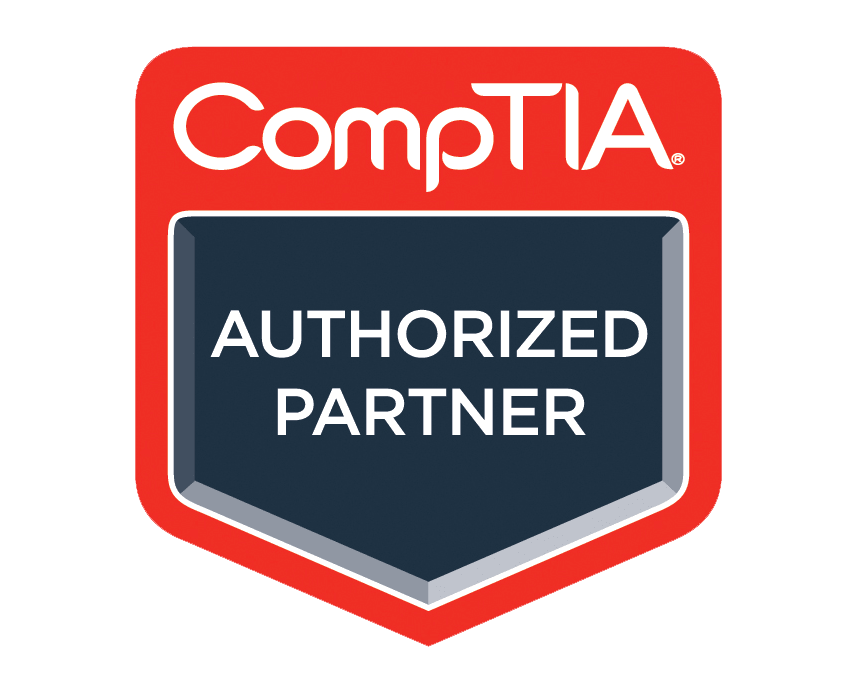Cybersecurity for Beginners
IT-TIAS30 - Network+, Linux+, Security+, PenTest+
Certification Exam Prep with vouchers
The Computing Technology Industry Association (CompTIA) is a leading voice and advocate for the $5 trillion global information technology ecosystem; and the estimated 75 million industry and tech professionals who design, implement, manage and safeguard the technology that powers the world’s economy.
Gain hands-on skills.
Build foundational knowledge.
Launch a successful cybersecurity career.
Network+
CompTIA Network+ helps develop a career in IT infrastructure covering troubleshooting, configuring, and managing networks. This certification validates the technical skills needed to securely establish, maintain and troubleshoot the essential networks that businesses rely on.
Linux+
CompTIA Linux+ proves you have the skills administrators need to secure the enterprise, power the cloud and keep systems running. Linux+ validates the competencies required of an early career systems administrator supporting Linux systems.
-
Unlike other vendor-specific networking certifications, CompTIA Network+ prepares candidates to support networks on any platform. CompTIA Network+ is the only certification that covers the specific skills that network professionals need. Other certifications are so broad, they don’t cover the hands-on skills and precise knowledge needed in today’s networking environments.
What Skills Will You Learn?
Networking Fundamentals
Explain basic networking concepts including network services, physical connections, topologies and architecture, and cloud connectivity.
Network Implementations
Explain routing technologies and networking devices; deploy ethernet solutions and configure wireless technologies.
Network Operations
Monitor and optimize networks to ensure business continuity.
Network Security
Explain security concepts and network attacks in order to harden networks against threats.
Network Troubleshooting
Troubleshoot common cable, connectivity, and software issues related to networking.
-
Network Security Operations
Network Security Analyst
Security Architect
Data Architect
Network Security Specialist
Solution Architect
Tier II IT Support Technician
Cybersecurity Analyst
-
Maximum of 90 questions
90 Minutes
Passing Score: 720 (on a scale of 100-900)
Security+
CompTIA Security+ is a global certification that validates the baseline skills necessary to perform core security functions and pursue an IT security career. Security+ opens the door to your cybersecurity career.
-
CompTIA Linux+ proves you have the skills required to support today's tech systems.
What skills will you learn?
System Management
Configure and manage software, storage, processes and services
Security
Understand best practices for permissions and authentication, firewalls, and file management
Scripting, Containers and Automation
Create simple shell scripts and execute basic BASH scripts, version control using Git and orchestration processes
Troubleshooting
Analyze system properties and processes and troubleshoot user, application and hardware issues
-
Penetration Tester
Cybersecurity Engineer
Data Architect
Solution Architect
Linux Engineer
Network Administrator
Web Administrator
Server Administrator
-
Maximum of 90 questions
Multiple choice and performance-based questions
90 minutes
Passing Score: 750 (on a scale of 100-900)
Recommended Experience
12 months of hands-on experience working with Linux servers. CompTIA A+, Network+ and Server+ recommended.
PenTest+
CompTIA PenTest+ is for cybersecurity professionals tasked with penetration testing and vulnerability management.
-
Why is Security+ different?
More choose Security+ - chosen by more corporations and defense organizations than any other certification on the market to validate baseline security skills and for fulfilling the DoD 8570 compliance.
Security+ proves hands-on skills – the only baseline cybersecurity certification emphasizing hands-on practical skills, ensuring the security professional is better prepared to problem solve a wider variety of today’s complex issues.
More job roles turn to Security+ to supplement skills – baseline cybersecurity skills are applicable across more of today’s job roles to secure systems, software and hardware.
Security+ is aligned to the latest trends and techniques – covering the most core technical skills in risk assessment and management, incident response, forensics, enterprise networks, hybrid/cloud operations, and security controls, ensuring high-performance on the job.
What Skills Will You Learn?
Attacks, Threats and Vulnerabilities
Focusing on more threats, attacks, and vulnerabilities on the Internet from newer custom devices that must be mitigated, such as IoT and embedded devices, newer DDoS attacks, and social engineering attacks based on current events.
Operations and Incident Response
Covering organizational security assessment and incident response procedures, such as basic threat detection, risk mitigation techniques, security controls, and basic digital forensics.
Architecture and Design
Includes coverage of enterprise environments and reliance on the cloud, which is growing quickly as organizations transition to hybrid networks.
Governance, Risk and Compliance
Expanded to support organizational risk management and compliance to regulations, such as PCI-DSS, SOX, HIPAA, GDPR, FISMA, NIST, and CCPA.
Implementation
Expanded to focus on administering identity, access management, PKI, basic cryptography, wireless, and end-to-end security.
-
Security Administrator
Systems Administrator
Helpdesk Manager / Analyst
Network / Cloud Engineer
Security Engineer / Analyst
DevOps / Software Developer
IT Auditors
IT Project Manager
-
CompTIA Security+ is the first security certification a candidate should earn. It establishes the core knowledge required of any cybersecurity role and provides a springboard to intermediate-level cybersecurity jobs. Security+ incorporates best practices in hands-on troubleshooting, ensuring candidates have practical security problem-solving skills required to:
Assess the security posture of an enterprise environment and recommend and implement appropriate security solutions
Monitor and secure hybrid environments, including cloud, mobile, and IoT
Operate with an awareness of applicable laws and policies, including principles of governance, risk, and compliance
Identify, analyze, and respond to security events and incidents
Security+ is compliant with ISO 17024 standards and approved by the US DoD to meet directive 8140/8570.01-M requirements. Regulators and government rely on ANSI accreditation, because it provides confidence and trust in the outputs of an accredited program. Over 2.3 million CompTIA ISO/ANSI-accredited exams have been delivered since January 1, 2011.
Maximum of 90 questions
Multiple choice and performance-based questions
90 minutes
Passing Score: 750 (on a scale of 100-900)
-
CompTIA PenTest+ is the most comprehensive exam covering all penetration testing stages. Unlike other penetration testing exams that only cover a portion of stages with essay questions and hands-on, PenTest+ uses both performance-based and knowledge-based questions to ensure all stages are addressed.
PenTest+ is the only exam on the market to include all aspects of vulnerability management. It not only covers hands-on vulnerability assessment, scanning, and analysis, but also includes planning, scoping, and managing weaknesses, not just exploiting them.
PenTest+ is the most current penetration testing exam covering the latest techniques against expanded attack surfaces. It is a unique exam that requires a candidate to demonstrate the most relevant pen testing skills for the cloud, hybrid environments, web applications, Internet of Things (IoT), and traditional on-premises.
What Skills Will You Learn?
Planning and Scoping
Includes updated techniques emphasizing governance, risk, and compliance concepts, scoping and organizational/customer requirements, and demonstrating an ethical hacking mindset.
Information Gathering and Vulnerability Scanning
Includes updated skills on performing vulnerability scanning and passive/active reconnaissance, vulnerability management, as well as analyzing the results of the reconnaissance exercise.
Attacks and Exploits
Includes updated approaches to expanded attack surfaces, researching social engineering techniques, performing network attacks, wireless attacks, application-based attacks and attacks on cloud technologies, and performing post-exploitation techniques.
Reporting and Communication
Expanded to focus on the importance of reporting and communication in an increased regulatory environment during the pen testing process through analyzing findings and recommending appropriate remediation within a report.
Tools and Code Analysis
Includes updated concepts of identifying scripts in various software deployments, analyzing a script or code sample, and explaining use cases of various tools used during the phases of a penetration test. It is important to note that no scripting and coding is required.
-
Penetration Tester
Security Consultant
Cloud Penetration Tester
Web App Penetration Tester
Cloud Security Specialist
Network & Security Specialist
-
Maximum of 85 questions
Performance-based and multiple choice questions
165 minutes
Passing Score: 750 (on a scale of 100-900)
Recommended Experience
Network+, Security+ or equivalent knowledge. Minimum of 3-4 years of hands-on information security or related experience. While there is no required prerequisite, PenTest+ is intended to follow CompTIA Security+ or equivalent experience and has a technical, hands-on focus.
CompTIA Training with the MyCAA Scholarship
What’s Included?
4 Exam Vouchers
Virtual practice labs
Practice exams
Mentor Support
This is an online, self-paced program. Self-paced programs create a unique learning experience that allows students to learn independently and at a pace that best suits them.
Total Duration: 8 Months
Coursework must be completed by the scheduled end date, per MyCAA guidelines. Students will have access to the course materials for one year.
Prerequisites: HS diploma/GED
Tuition: $3,997
Course Breakdown
-
OSI Model Layers and Data Encapsulation
Network Types
Cables and Connectors
IP Addressing Schemes and Subnetting
Well-Known Ports and Protocols
Registered Ports
Network Services and Data Center Architectures
Cloud Concepts
Network Implementations
Ethernet Switching and Wireless Standards
Network Operations
Disaster Recovery and High Availability Concepts
Security Concepts and Threats
Physical Security and Network Hardening
Network Troubleshooting Methodologies & Tools
Troubleshooting Network Issues
-
Introduction to Linux and the Command Line
Managing Users and Groups
File Access and Permissions
Disk Partitions & File Systems
Logical Volumes & File System Hierarchy
Using vi/vim to Edit Files
Locating and Manipulating Files
Searching and Manipulating File Contents
Boot Process and Kernel
Graphical User Interfaces
Managing Services
Troubleshooting Services
Managing and Configuring Hardware
TCP/IP and Networking
Troubleshooting Network Connections
Installing and Managing Software
Installing Software from Source Code
Security Best Practices
SELinux & AppArmor
Network Firewall and Traffic Filtering
Backup and Restore
Bourne-again Shell and Scripting
Scheduling Tasks
Gift Version Control
Installing CentOS
Installing Ubuntu
-
The Present Threat Landscape
Types of Malware
Social Engineering and Related Attacks
Application and Service Attacks
Cryptographic and Wireless Attacks
Penetration Testing and Vulnerability Scanning
Impacts from Vulnerability Types
Components Supporting Organizational Security
Security Assessment Using Software Tools
Cryptography
Public Key Infrastructure
Wireless Security Settings
Analyzing Output from Security Technologies
Deploying Mobile Devices Securely
Implementing Secure Protocols
Troubleshooting Common Security Issues
Identity Concepts and Access Services
Identity and Access Management Controls
Common Account Management Practices
Frameworks, Guidelines, and Physical Security
Implement Secure Network Architecture Concepts
Secure System and Application Design and Deployment
Cloud, Virtualization, and Resiliency Concepts
Policies, Plans, and Procedures
Business Impact Analysis and Risk Management
Incident Response, Forensics, and Disaster Recovery
-
Planning for an Engagement
Scoping an Engagement
Information Gathering
Vulnerability Identification
Social Engineering and Specialized System Attacks
Network-Based Exploits
Application-Based Vulnerabilities
Local Host Vulnerabilities
Post-Exploitation and Facilities Attacks
Penetration Testing Tools
Analyzing Tool and Script Output
Reporting and Communication
REFERENCE MANUAL: CompTIA PenTest+ Certification Practice Exams (Exam PT0-001)



